Air Tanzania

Air Tanzania Corporation (ATC), the Tanzanian carrier, was established on 11 th March 1977, to continue operations following the collapse of East African Airways (EAA), and the flagship by the were two Boeing 737-200.
In 2016, the Tanzanian government under former President John Magufuli launched a new push to revitalize Air Tanzania by acquiring additional aircraft from Bombardier and Boeing, to boost tourism, trade and investment.
With this decision, Air Tanzania was saved instead of slowly fading away. Successes and setbacks hit most airlines - but hold out Air Tanzania
Updated 10th September, 2024 (Text and pictures)

With increased demand for cargo transportation between The Comoros and Tanzania, Air Tanzania Company Limited (ATCL)’s Boeing 767-300F cargo plane is scheduled to commence flights to Moroni next month.
 Air Tanzania Boeing Dreamliner 787-8 5H-TCR msn 67792 named "The Great Serengeti Migration" was met by water cascades in the evening at Julius Nyerere International Airport, Dar es Salaam on 15th August 2024.
Air Tanzania Boeing Dreamliner 787-8 5H-TCR msn 67792 named "The Great Serengeti Migration" was met by water cascades in the evening at Julius Nyerere International Airport, Dar es Salaam on 15th August 2024.
 What is going on. The latest news is that Air Tanzania Bombardier Dash8-300 left Luqa Malta airport as TC308 for further maintenance at Mersa Matruh-Egypt!
What is going on. The latest news is that Air Tanzania Bombardier Dash8-300 left Luqa Malta airport as TC308 for further maintenance at Mersa Matruh-Egypt!
DE HAVILLAND WILL START A REFURBISMENT PROGRAMME
OF DASH Q400

De Havilland Aircraft of Canada announced of the 2024 Farnborough International Air Show on 22 July that De Havilland OEM Certified Refurbish Program will acquire and remarking the aircraft for specific customers and so far the have acquired twenty-eight Dash 8-400 for re-building to state of the art.
TGF Tanzanian government Flying Agency which provides VIP flight services to government officials has purchased a used De Havilland DHC Dash Q400 from De Haviland Aircraft of Canada for early delivery.
Air Tanzania ATCL which had only one operational aircraft in 2015 now boast a fleet of 15 aircraft. Today, 5 aircraft are on the ground with engine problems or with the difficulty of procuring spare parts.

This is the only Airbus A200-300 5H-TCH "Dodoma" that operates for Air Tanzania here seen at Abeid Amani Karume International Airport, Zanzibar, Tanzania.
The most pressing issue is the situation with the Airbus A220 aircraft. Of 4 Airbus A220-300, 3 no 5H-TCI, 5H-TCL and 5H-TCM are grounded due to problems with the Pratt & Whitney engines including corrosion and engine faults, have led to flight disruptions and revenue loss. Due to failure of its engines with the manufacturer allegedly failing to secure new engines in the process causing losses to its customers who has purchased the planes.
 The Boeing 787-8 Dreamliners 5H-TCG is still stranded in Malaysia since August 2023 to have the maintenance of its engines.
The Boeing 787-8 Dreamliners 5H-TCG is still stranded in Malaysia since August 2023 to have the maintenance of its engines.
The Bombardier Q300 5H-MWF has been stranded at Luqa Malta airport for more then 3 years, but has now been flewn to Mersa Matruth airport, Egypt for further maintenance
Air Tanzania has faced continuous financial losses, with the recent fiscal year reporting a substantial loss of 56.64 billion/-. High operating and fixed costs, particularly related to aircraft leases and technical issues with Airbus A220-300 planes, have contributed to the financial woes.
Air Tanzania Company Limited is on an aggressive expansion drive as it welcomes Boeing 737-9 Max, its second aircraft from the US carrier manufacturer. A second Boeing 737-9 Max symbolizes Tanzania’s steady journey in enhancing its aviation sector but also sets the stage for the airline’s ambitious plans for growth and operational excellence.
In 15th August the 3rd Air Tanzania Boeing Dreamliner 787-8 5H-TCR msn 67792 named "The Great Serengeti Migration" was met by water cascades in the evening at Julius Nyerere International Airport, Dar es Salaam

A super picture of Air Tanzania Boeing 787-8 5H-TCJ arriving Guangzhou - Brijun China in 2023.
In 2016, the Tanzanian government under former President John Magufuli launched a new push to revitalize Air Tanzania by acquiring additional aircraft from Bombardier and Boeing, to boost tourism, trade and investment.
The government has been considering changing air traffic control operations depending on market conditions. The Tanzanian carrier, which faces stiff competition from three far more dominant carriers, Ethiopian Airlines, RwandAir, and Kenya Airways, has planned to increase its fleet from 11 to 14 aircraft this year and operate more long haul and regional flights, including to West Africa.
The Fleet
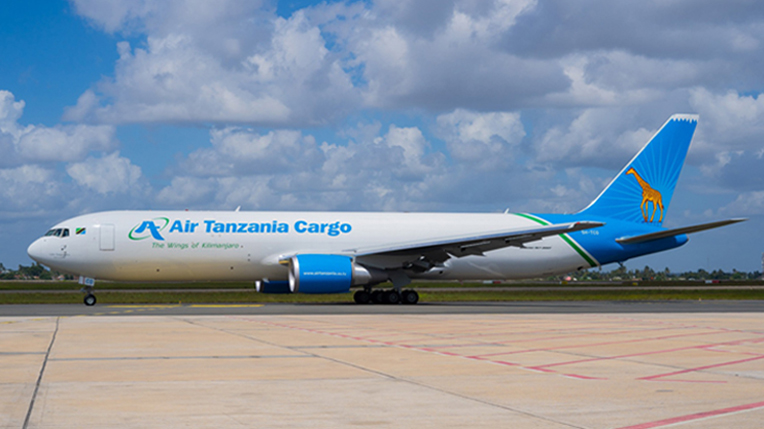
The latest aircraft to be delivered to Air Tanzania Boeing 767-300 5H-TCO

The Boeing 787-8 Dreamliner at Guanqzhoo - Baiyon 27th November 2022

Air Tanzania Boeing 737-MAX9 5H-TCP named Olduvai Gorge on October 4th, 2023.
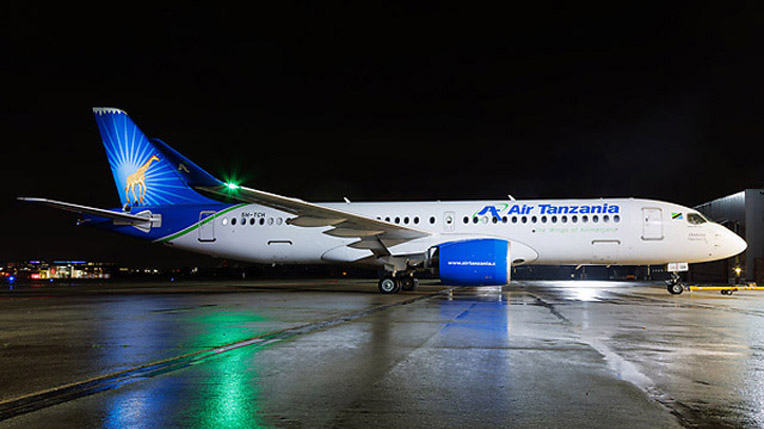 Airbus A220-300 5H-TCH
Airbus A220-300 5H-TCH

Bombardier Q400NG 5H-TCF

Air Tanzania De Havilland Dash Q300 5H-MWF has been grounded for more than three years as it is in maintenance.

Air Tanzania Boeing 720-022 N62215 that only could carry 29 passengers.
History
1977
Air Tanzania Corporation (ATC), the Tanzanian carrier, was established on 11 March 1977, to continue operations following the collapse of East African Airways (EAA), which was owned jointly by the governments of Kenya, Tanzania and Uganda. EAA operations came to complete halt in January 1977 resulting in the dissolution of EAA, the "Pride of East Africa".
Strained relations between the three member-states in the EAA culminated in Kenya's decision to with its participation in the joint EAA.
The governments of Tanzania and Uganda, which had been partners in the formation the to EAA, were at a disadvantage vis-à-vis to Kenya, which had the EAA Embaksi headquarters in Nairobi, Kenya.
Tanzania and Uganda did not receive a fair share of the former airline's assets, even through they were equal partners because the Kenyan government was the EAA's main creditor. Realizing the imminent collapse of the EAA, Kenya secured aircraft from the EAA's bankruptcy and repainted the aircraft in Kenya Airways new colors two days after the EAA's dissolution.

The first to join Air Tanzania was this East African Airways Fokker F27-200 5Y-AAC
Tanzania inherited two Fokker F27-200 5Y-AAC and 5X-AAP from the defunct airline but did not have local organizations like Kenya Airways at the former EAAC offices and maintenance hangars in Embakasi, Nairobi.
Its territory was much larger than that of its former partners, requiring aircraft of different sizes. Air Tanzania considered Fokker F27s and De Havilland Twin Otters, which were suitable for unpaved airports.

Air Tanzania leased this Douglas DC-9-30 5Y-BBR from Kenya Airways.
Air Tanzania began operations operation in 1977 with a leased Douglas DC-9-32 5Y-ALR from Kenyan Airways a new airline established by the Kenyan government and inherited Fokker F27-200s from the defunct East African Airways.
After negotiations with various creditors or banks, the Tanzanian government ordered placed an order for two Boeing 737-200s, three new Fokker F27-600s and four DHC-6 Twin Otters all financed by a US bank. All to be delivered during the 1977-78 period.

DETA Boeing 737-200 CR-BAD
Air Tanzania has leased a Boeing 737-200 from Mocambique DETA and now waiting for the first new Boeing 737-200 to join its fleet.

The first De Havilland DHC-6 5H-MRD, destined Air Tanzania
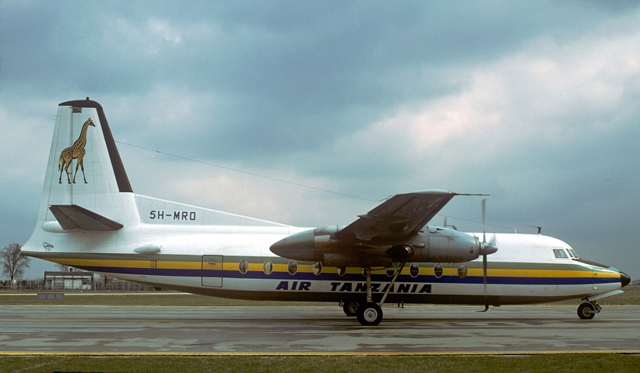
Next to join the Air Tanzania fleet is the Fokker F27 5H-MRD
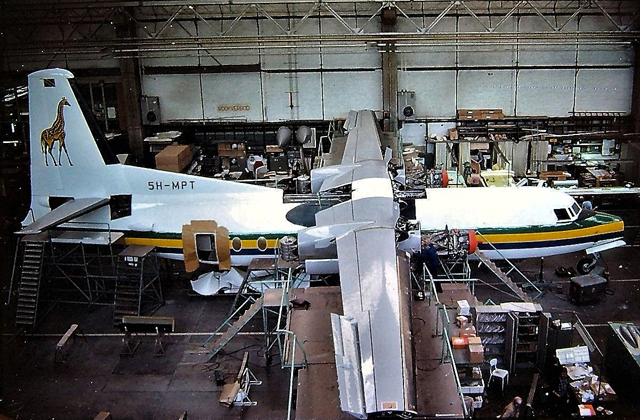
Back in the paint-shop to get the eye-catching color livery

Air Tanzania F27 PH-EXD ready to be delivered as 5H-MRM
The first DHC-6 Twin Otter and the Fokker F27s ordered were painted in a traditional, green, yellow, black and white colors but were repainted in the factory to the new eye-catching colors blue and yellow before being delivered Air Tanzania in Dar es Salaam.
The Twin Otters were based at Kilimanjaro Int. Airport for domestic flights. Due to declining traffic, two of the F27s were withdrawn from service in 1981, but returned two years later, only to be withdrawn again in 1984.

Olympic Airways Boeing 720-51B SX-DBN
This Boeing 720-051B SX-DBN in full paint from Olympic Airways was never taken in use.
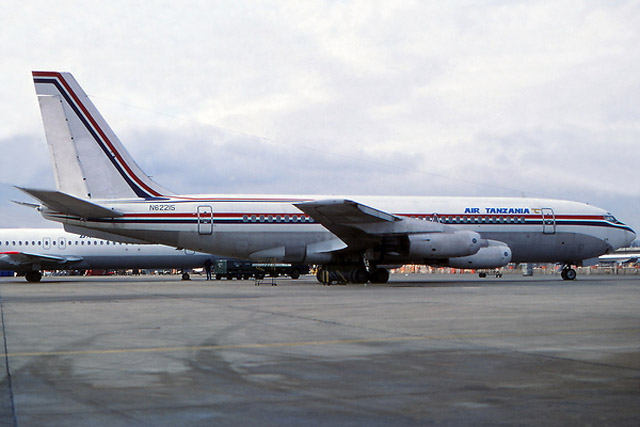

Air Tanzania Boeing 720-022 N62215 that only could carry 29 passengers.
Meanwhile, waiting for delivery of the factory new Boeing 737-200, Air Tanzania hurriedly
to rent a Boeing 720-022 N62215 with crew from Caledonian Airlines Ink. Unfortunately with substandard contracts. The Boeing 720 was originally designated 707-020 but was later changed for marketing reasons. It was a shortened version of the 707-120 and, as such, was both lighter and faster for use on medium-range flight with shorter airport runways.
When it finally entered service operation, it turned out that the Boeing 720 could only carry 29 passengers, a fact that Caledonian undoubtedly not mentioned to Air Tanzania .
The last action according to Air-Port Data, 1982-10-15-The aircraft stood idle at Kilimanjaro airport for many years and nd probably scrapped localy.
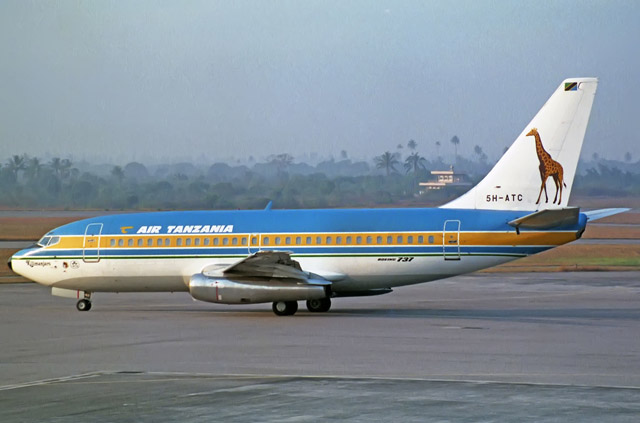
Air Tanzania Boeing B737-200
Finally in December 1978, the first Boeing 737-2R8C Adv, 5H-ATC named Kilimanjaro was delivered to Air Tanzania wearing the attractive colors of Air Tanzania which were based on the national flag, followed by the Fokker F-27 5H-MPU and a De Havilland DHC-6 Twin Otter 5H-MRC.

Air Tanzania B707-331 N762TWA msn 17675 delivered by Caledonian 80-05) here seen. at London/
Gatwick Int airport 1980.

Air Tanzania De Havilland DHC-6 Twin Otter 5H-MRB on Malta
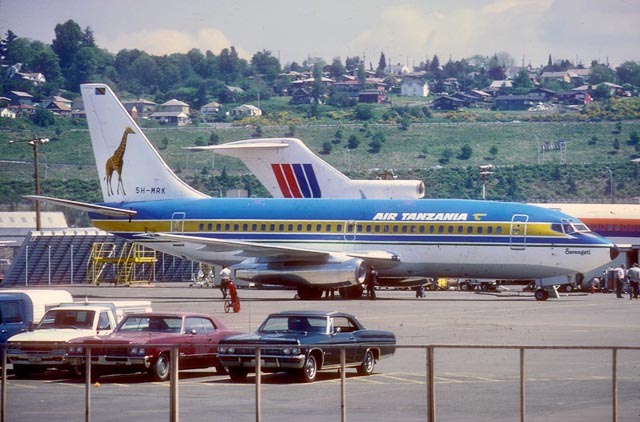
Air Tanzania Boeing 737-2RSC 5H-MRK ready to be delivered to Air Tanzania 1979.
Starting and running an airline is no easy task. It is even more difficult to establish and operate a profitable airline, only those with business acumen, industry knowledge, and long-term vision have a chance of surviving in this incredibly competitive environment.
Air Tanzania was quite profitable in during the 1980s. The airline maintained its well developed flight network in a more or less acceptable manner. However over the years the airline experienced frequent delays and flight cancellations. Sometimes they flew with smaller aircraft than indicated in the flight schedule.
Air Tanzania was financially affected by the Gulf War. Escalating fuel costs for fuel among other things, meant that the fleet was not maintained. There was also a lck of funds fpt the acquisitio of new aircraft.
Air Tanzania's history is marked by faild privatization, dysfunctional alliances and a controversial aircraft leasing agrement that led to the airline not enjoying among passengersand beeing jokingly referred to as "Any Time Cancellation" due to its unpredictable flights scedule.

Air Tanzania leases McDonnell MD-83 G-BNSA from British Island Airways
In 1989, Air Tanzania had to lease a replacement aircraft for the first time because one of the airline's Boeing 737s was undergoing heavy maintenance. The airline then leased a McDonnell MD-83 G-BNSA from British Island Airways during 1989
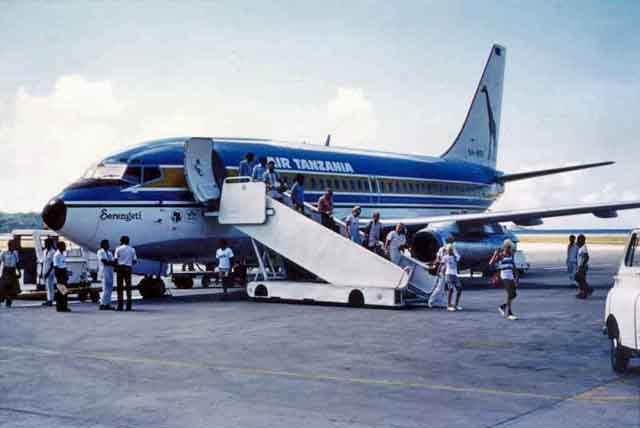
Air Tanzania Boeing 737-2RSC 5H-MRK at Seychelles 1981.
Ambitiously, Air Tanzania extended its service new Boeing 737-200 to Maputo, Lusaka, Tananarive and the Seychelles 1979.
With two new Boeing 737-200s, five Fokker F27s and two De Havilland DHC Twin Otter, the airline began opertions within carrier started services within Tanzania and the neigthbouring countries in late 1979.
 Tanzania Fokker F27-200 5H-MRM at Zanzibar
Tanzania Fokker F27-200 5H-MRM at Zanzibar

In May 1991, Air Tanzania began operating a Boeing 767-200ER leased from Ethiopian Airlines. The aircraft was operated only once a week from Dar es Salaam to London via Kilimanjaro, Rome, Frankfurt to London.
On the "maiden flight" only six passengers were onboard. Another reason for the suspension of operations was that ATC did not reimburse the other airlines to connecting flights. The aircraft proved to be to large and uneconomical. So it was returned to the lessor in February 1992.

Air Tanzania Boeing 767-300 ET-AIZ at London, Gatwick 1991.
Note: No airline has the finances to have aircraft in its fleet that only operate once a week.

Air Tanzania Fokker F27-200 5H-MPT delivered new 22 Nov 1977
In December 1993, the Air Tanzania Fokker F27-training flight crashed at HTDA. The crew was completing on local training flight at Dar es Salaam Airport. The aircraft landed at excessive speed and in a configuration without flaps. Upon touchdown, the landing gear was torn off, and the aircraft came to rest on its belly. Both pilots were uninjured, but the fuselage of the aircraft was so badly damaged that it could not be repaired and was used as a spare.
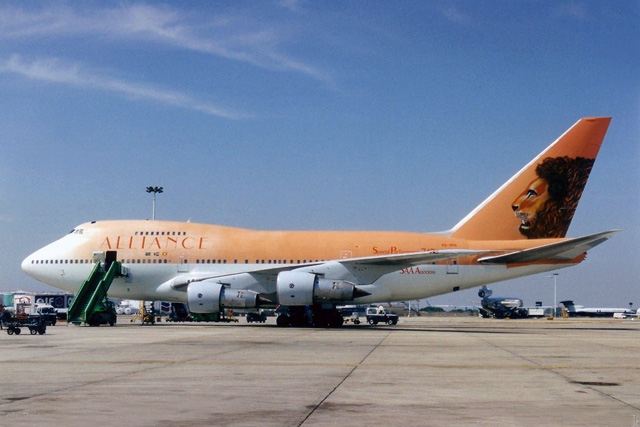 br>font size=3>Alliance Air Boeing B747SP ZS-SPA
br>font size=3>Alliance Air Boeing B747SP ZS-SPA
In 1994, Air Tanzania merged with Uganda Airlines and South African Airways (SAA) to form Alliance Air. Air Tanzania held a 10 percent stake in the venture. Flights from Dar es Salaam to London, Heathrow via Entebbe were initially operated with a Boeing 747SP and later with a smaller Boeing 767-200.
Alliance Air had planned to serve Dar es Salaam, Dubai, Entebbe, Johannesburg, London and Mumbai. Flights to Rome were to be launched at a later date. The airline's launch sent shock waves through Kenya Airways, the dominant airline in the region.
The company ceased operations in October 2000 after accumulation losses of about $ 50 million. The losses had been financed by Transnet, the parent company of SAA, until April 2000. When Transnet refused to continue funding the deficit, Air Tanzania accused SAA of using Alliance Air "as a Trojan horse to takeover the national airlines in the region.
Air Tanzania Corporation left this venture in June 1998 and hailed by the airlines a "constant obstacle". Uganda Airlines also parted ways within Alliance Air following year.

Air Tanzania Boeing leased this Boeing 737-300, 5H-TCA 1999-2003 from Ansett Airlines, Australia.

An odd bird Air Tanzania Dornier Do 228-201 ZS-OVM
Air Tanzania leased this "Beauty", the Dornier Do 228-201 from VSA Aviation in South Africa for a short period, from February 15 to 2002 October 5 2003. This aircraft could also use grass runways.
The airline was wholly owned by the Tanzanian government until 2002 when it was partially privatized on the instructions of the Bretton Woods institutions to implement the country's structural adjustment program.
In February 2002, the government began privatizing ATC through the Presidential Parastatal Sector Reform Commission. Advertisements were placed in the local, regional, and international media inviting potential bidders. The International Finance Corporation advised the government on this transaction.
Of the eight bidders, four airlines conducted due diligence: South African Airways, Kenya Airways, Comair, and Nationwide Airlines. As of 19 September 2002, the deadline for bidding, only SAA had submitted a bid. Kenya Airways and Nationwide Airlines had notified the government that they did not intend to bid.
On September 19, 2002, South African Airways (SAA) submitted a technical and financial bid too acquire a 49 percent stake in Air Tanzania.
The Tanzanian government selected SAA as the successful bidder. After signing an agreement with the government, SAA acquired a 49 percent stake in Air Tanzania Limited (ATCL) in December 2002 for UD$20 million. US$10 million was the value of the government's shares and the remaining US$ 10 million was for the capital and training account fund to fund Air Tanzania's proposed business plan.
As a strategic partner, SAA planned to establish its East African hub in Dar es Salaam to form a "Golden Triangle" between southern, eastern, and western Africa. In addition, ATCL's old fleet was to be replaced by Boeing 737-800 and Boeing 767-300 aircraft.
2003
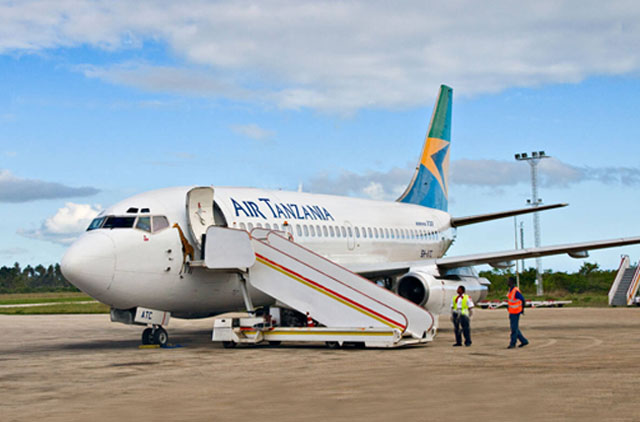
Air Tanzania Boeing B737-200 5H-ATC in Alliance painting.
The new Air Tanzania airline was launched on 31 March 2003, offering direct flights between Johannesburg and Dar es Salaam, but also to Zanzibar and Kilimanjaro.

Air Tanzania Boeing B737-200 5H-MRK arriving in Johannesburg.
Air Tanzania posted a pretax loss of nearly US$7.3 million in its first year after privatization. The loss was mainly attributed to the fact that the network could not expanded as quickly planned. It had been hoped to establish flights to Dubai, India, and Europe, but this was delayed as Air Tanzania only Boeing 737-200s in its fleet. The development of Dar es Salaam as an East African hub for the SAA alliance also did not proceed as quickly as planned.
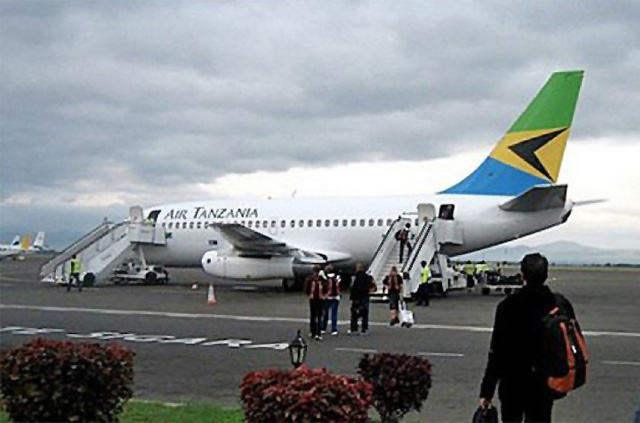
Air Tanzania Boeing B737-200 5H-MVA in alliance painting.
Problems arose after only a few months, because SAA had promised that the aircraft fleet would be renewed and Dar es Salaam would become a new hub in SAA's traffic. None of the promised conditions were met. The two older Boeing 737-200s were replaced with equivalent aircraft, and only two Fokker F28 jets and two De Havilland DHC-8 Q200s were made aviable to the company.

Air Tanzania Boeing B737-200 5H-ATC in Alliance painting.
Air Tanzania discountinued one of its few regional flights Dar es Salaam to Nairobi, on January 2005 after Kenya Airways created strong competition on the route. However the airline, reaffirmed its intention to launch long-haul flights from Dar es Salaam to Dubai, London, Mumbai, and Muscat within a year.
On March 31,2006, the Tanzanian government announced that it would divest ATCL after four years of losses, totaling TSh 247 billion. In reponce the Director General ofthe Tanzanian Civil Aviation Authority, Margaret Munyagi said "Air Tanzania was in a
worse condition than before it was taken over by SAA"Tanzanian government announced on 31 March 2006 that it would dispose of ATCL following four years of losses, which amounted to TSh.24.7 billion. The director-general of the Tanzania Civil Aviation Authority, Margaret Munyagi, said: "Air Tanzania was in a worse state than before it was taken over by SAA." SAA the Director of Tanzania Civil Aviation Authority Margaret Munyagi however, claimed that the Tanzanian government was "not serious" for not realeasing US$30 million needed to implement Air Tanzania's business strategy to reverse its continuing losses.
On September 7 2006, the Tanzanian government bought SAA's 49 percent stake in ATCL for US$1 million, officially ending its partnership with SAA. The venture failed because of the partners' divergent interests in the business.
The Tanzanian government could not accept this and decided to buy back its stake in South African Airways. The partnership lasted for four years and had accumulated losses of more than US$19 million.
On September 7 2006, the Tanzanian government bought the 49 percent stake from SAA stake in ATCL for US$1 million, officially ending the partnership with SAA
Following the official termination of Air Tanzania partnership with South African Airways (SAA), the government provided TSh.13 billion to enable Air Tanzania to use its own tickets(No 197) instead of those of SAA (number 083), convert revenue systems and fuel services, set up e-ticketing and accounting systems, use a new trademark, and settle outstanding debts. President Kikwete appointed Mustafa Nyang'anyi, a veteran politician and diplomatic ambassador, as the cheif executive officer, and David Mattaka, former Parastatal Pensions Fund as executive director and chief executive officer.
Air Tanzania Company Ltd (ATCL "Wings of Kilimanjaro" was re-launched in September 2007 with two leased Boeing B737-200 5h-ATC and 5H-MVZ after the
partnership with South African Airways (SAA) was dissolved.

Air Tanzania Boeing 737-200 ATC in the new temporary livery, with a white fin and a Giraffe fitted on the nose.
ATCL had been struggeling with acute administrative, technical and financial difficulties for several years after the joint venture with South Africa Airways was unceremoniously terminated in 2006 following contractual misunderstandings.
In this context, the government also began searching for another private partner to
operate the airline. Initial talks began with China Sonangol Int. Limited in 2007.
The following year a joint venture with a Chinese firm, Sonangol Holdings Limited,was proposed but never materialized, resulting only in the purchase of two De Havilland Dash Q311 (5H-MWF and 5H-MWG) aircraft.
Sonangol Ltd assisted the Tanzanian government representative in drafting the lease agreement, with a lease price of $370,000 per month for the used Airbus aircraft to Wallis Trading Company, which later resulted in a costly Airbus A320 lease. The lease was signed prior to the approval of a government guarantee, contrary to the Government Guarantee and Loan Act of 1974, as amended in 2003, and raised serious concerns with the Controller and Audit General, who subsequently recommended discipline of all executives involved in the fraud.
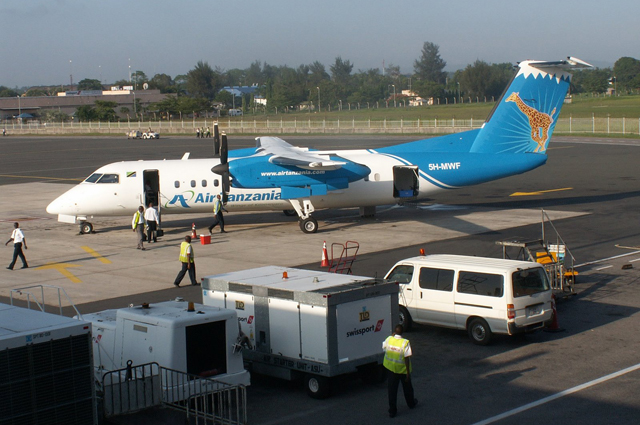
Air Tanzania De Havilland Canada DHC-8-311Q Dash 8 5H-MWF at Dar es Salaam Int. Airport.

Air Tanzania De Havilland Dash Q300 5H-MWG preparing for take-off from Zanzibar Int.airport.
The two De Havilland Canada DHC-8-311Q Dash 8 5H-MWF and 5H-MWG were delivered in February 2007 and De Havilland Dash Q300 both became the workhorses on Air Tanzania domestic routes to Mwanza, Kigoma and Zanzibar and Haya on Comores Islands.
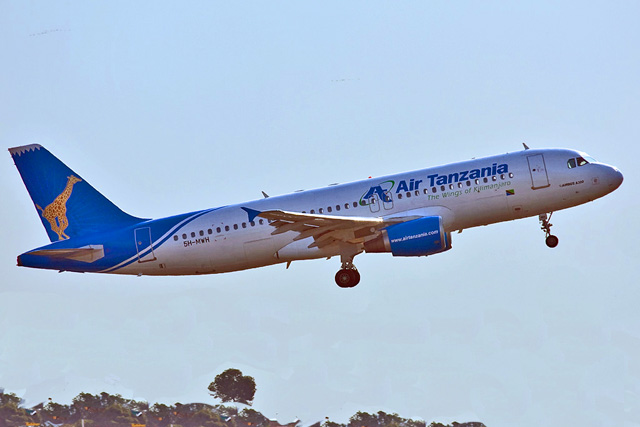
Air Tanzania De Havilland Dash Q300 5H-MWH on take-off from Dar es Salaam Int. airport.
The Airbus 5H-MWH A320 joined the fleet in May and was fully painted Air Tanzania new livery. The Airbus will be used primarely on key routes between Dar es Salaam and Johannesburg.

Air Tanzania De Havilland Canada DHC-8-311Q Dash 8 5H-MWF and Airbus A320-214 5H-MWH.
The inaugural flight departed Dar es Salaam on October 1. 2007 via Kilimanjaro to Mwanza. The introduction of the airline's new logo on a leased Airbus A320 carried image of the imposing giraffe, Tanzania's national symbol and replaced the flag symbol of South African Airways.
Various problems began to emerge as early as the beginning of December. Air Tanzania was faced with the fact the two of its aircraft had to be taken out of service. The Airbus A320 had to be grounded due to that two of the aircraft had to be taken out of service.
The Airbus A320 aircraft had to be grounded due to the unknown fact (such as that signing a contract it is important to read all the little paragrphs in contract, aircraft needs a flight time check in December) that the flight time withdrawal was almost expired and the aircraft had to undergo a D-check as well as the De Havilland Canada DHC-8-311Q Dash 8 5H-MWG which was also was grounded for heavy maintenance. The airline had not been aware of the status of the aircraft prior to the acquisiton . There were no plans for aircraft to replace the grounded aircraft.
A week later, the Tanzania Civil Aviation Authority (TCAA) revoked Air Tanzania's AOC because the airline had not met International Civil Aviation Organization standards. Two weeks later, the International Air Transport Association (IATA) banned the carrier from all air transport operations and informed all travel agents and other air carriers to cease all business with Air Tanzania until further notice.
However, the certificate was restored in January 2009, with both the TCAA and Air Tanzania claiming there had never been any doubt about the airworthiness of their aircraft. Air Tanzania's fleet now considered of an older Boeing 737-200 and a ten- years old Bombardier Q300.

Air Tanzania De Havilland Canada DHC-8-311Q Dash 8 5H-MWG bound for Johannesburg
The De Havilland Canada DHC-8-311Q Dash 8 5H-MWG was been transferr to South Africa for maintenance. The Airbus was flown to Mauritius in March 2009 to perform the required heavy maintenance to be carried out by Air Mauritius. In July the aircraft was flown to Sabena Technics in France. The aircraft never returned to Tanzania.
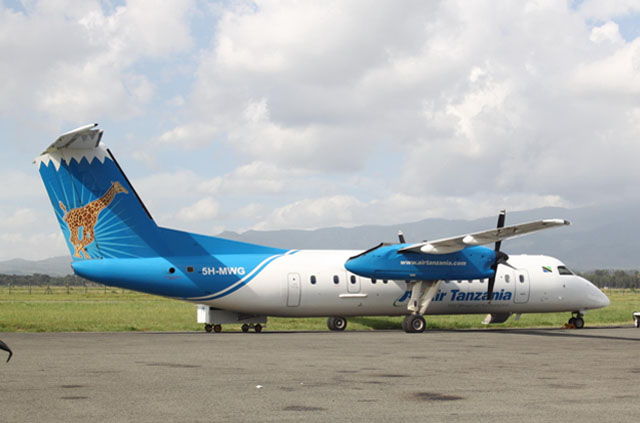
Air Tanzania De Havilland Canada DHC-8-311Q Dash 8 5H-MWG
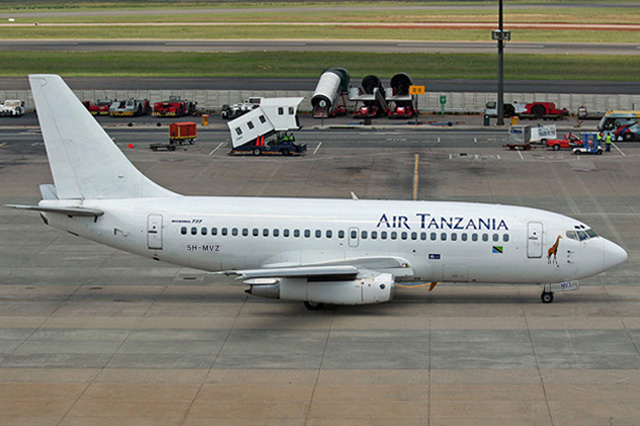
Air Tanzania 5H-MVZ at Johannesburg,
Air Tanzania continued to fly mainly domestic flights to Mwanza, Kigoma and the regional destination of Haya in the Comoros. In 2009, Air Tanzania carried only 60,018 passengers as it had only two aircraft in its fleet, while Precision Air carried moved 583,000 passengers and Coastal Aviation 141,995 passengers.
In July 2010, the Airbus A320 was returned to the lessor, a Lebanese company, Wallis Trading Company. The government incurred a loss of $39 million on the lease of the Airbus, which according to the report was not flown. However the report also indicates
that Air Tanzania stopped making payments(without giving a reason) and the debt accured from the deals withthe Lebanese company rose to $200 million, enough to buy three brand new Airbuses of the same series. According to the average list prise for Airbus Aircraft 2010the order price for a brand new Airbus A320 series is $88.3 million.
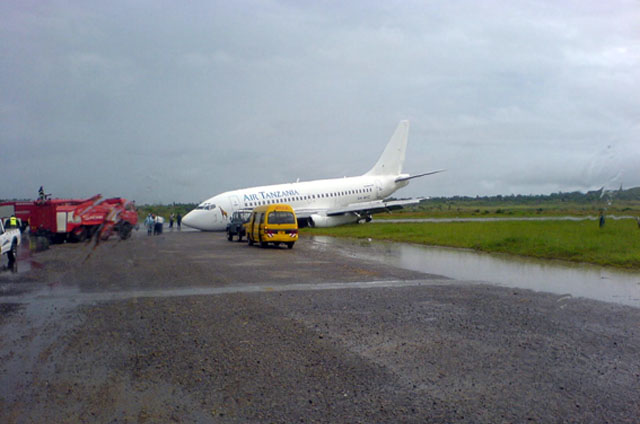
Air Tanzania Boeing 737-200 5H-MVZ skidded off the runway and was stuck in the grass.
Air Tanzania's Boeing 737-200 5H-MVZ skidded off the runway and became stuck in the grass on March 1,2010 1st 2010 March Air Tanzania Boeing 737-247 5H-MVZ sustained significant damage suffered substantial damage in a accident after landing at Mwanza Airport an was written off. The aircraft had departed from Dar es Salaam as flight TC100. Theen route leg of the flight passedwithout incident. At 07:22the flight contact runway excursion accident after landing at Mwanza Airport and was written off. The aircraft had departed from Dar es Salaam as flight TC100. The en route part of the flight was uneventful. At 07:22 hours the flight contacted the Mwanza Tower Controller and requested information on the local weather.
The captain flew the aircraft. He testified that the approach to Runway 30 and touchdown were normal. He also claimed that after electing to reverse thrust, the aircraft run into a puddle of water affected its performance and control capability and caused it to veer off the runway. Approxemately 5 meters of the right wing extended into the runway and the forward portion of the airplane rested on the asphalt ofm the service road tarmac surface of a service road. There were no injuries.

Air Tanzania Boeing 737-200 5H-MVZ awaiting to be scrapped.
The aircraft suffered damage to its fuselage,nose-gear right engine. It was deemed beyond repair and remaind at the airfield and beyond repair forengine and the aircraft was considered beyond repair and remained at the airfield for many years until it was finally scrapped.
At the same time that the Boeing 737-200 5H-MVZ was grounded, its De Havilland Canada DHC-8-311Q Dash 8 5H-MWF was undergoing a heavy C-check at ATCL's hangar in Dar es Salaam, having been stranded there due to lack of funds to import spare parts from abroad.

Air Tanzania De Havilland Dash Q300 5H-MWF awaiting spareparts
Since 2011, the airline has been in a constant, downwardspiral and has had down operations several imes due to lack of aircraft.

Air Tanzania De Havilland Dash Q300 5H-MWG leaves Johannesburg
Air Tanzania suspended operations in March 2011, after its only remaining operational aircraft, a De Havilland Canada DHC-8-311Q Dash 8 (5H-MWG), was sent to South Africa for maintenance, and the airline was stuck because it could not find a suitable lease for the aircraft. Tanzania resumed operations in November 2011 after the return of the De Havilland Canada DHC-8-311Q Dash 8 5H-MWG. Maintenance costs were US$1 million, but other accrued costs brought the total bill to $3 million, which the Tanzanian government paid in September 2011.
On November 21, 2011, Air Tanzania entered into negotiations with Export Development Canada (EDC) to explore how EDC could assist the airline in procuring additional aircraft from Bombardier, a Canadian aircraft manufacturer (formlery De Havilland). However,these negotiations failed due to the airline's high level of debt.
of debt.
In 2012, the Auditor General again addressed massive emnezziement and ismanagement associated with the Airbus A320 lease resulted in a US$45 million debt accumulated Willis Trading in Octoner 2012.
The aircraft was owned by ATCL for 48 month but spent 41 month month in France undergoing major maintenance.

Air Tanzania/Aerovista Boeing 737-500 4L-ABJ on the apron, Dar es Salaam Int. airport
On March 29, 2012, Air Tanzania (Tanzanian government) and AeroVista (Dubai) signed a strategic joint venture agreementunder which Aerovista would lease its B737-500 4L-AJB to Air Tanzania the crew, pilots and attendants,and engineers for the Boeing 737-500 at its Dar es Salaam, facility.
Even before the agreement was signed, experts at the Tanzania Civil Aviation Authorty pointed out that the aircraft was considered obsolent for its time and quite fuel intensive.
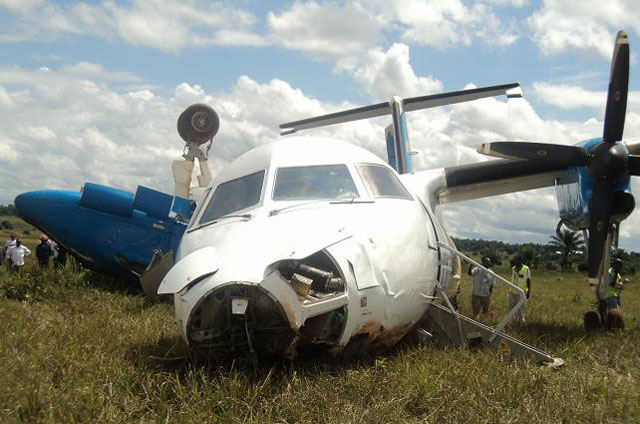
Air Tanzania Bombardier Q300 last take off!
On 9th April 2012 the airline was hit again when their De Havilland Canada DHC-8-311Q Dash 8 5H-MWG, substantial damage in a takeoff accident at Kigoma Airport (TKQ), Tanzania. An Air Tanzania de Havilland Dash 8-300 performing flight TC-119 from Kigoma to Dar es Salaam via Tabora with 35 passengers and 4 crew, rejected takeoff from Kigoma's runway 34 due to an engine failure but overchud the runway and came to a stop with the nose gear collapsed and the right wing including engine and right hand main gear separated at around 10:15L. There were no fatalities.
It later became apparent that the ag that had been worked out had not been coordinated with the Tanzanian government, andthere wash a push to terminate the contract early. The contract stipulated that AeroVista would deliver another aircraft,which would dramatically increase. AeroVista's profits. The government the tried to increase taxes, which was not approved by the lessor.andended the negotiations.
After negotiations with AeroVista in late July decided to tax AeroVista too much if it were add to add an additional aircraft to its fleet. AeroVista deemed iteconomically unsustainable tocontinuethe airline business. On August 7, 2012, the Tanzania government terminatedthe contract early, The government attempted to wriggle out of contract and were unable to reach ab aggrement . According to negotiate a new agreement tocontinue the joint venture with the government
On August 7. 2012, the Tanzanian government terminated the agreement prematurely. All this was was hidden in an obscurity but the goverment's intension was clear, the government tried to wriggle out of the contract and that the parties could not reconcile. Acccording uncertain sources, Air Tanzania tried to negotiate a new agreement to continue the joint venture again but it did not come to frutation.
The Tanzanian government had provided US $3.1 million to the national airline to fund aircraft maintenance, operations, and salaries for 200 employees injected USD3.1million into the national carrier to pay for aircraft maintenance, operations as well as the salaries of the 200 workers
The aircraft was returned to AeroVista. As a result, Air Tanzania did not have access to an aircraft to maintain key services to Mwanza and Kigoma, as its only owned aircraft a De Havilland Dash Q300, underwent heavy maintenance promting the airline to suspend operations and rebook passengers on other airlines.

Air Tanzania Boeing 737-200 at Mwanza Int Airport
Two months later, on October 12, 2012, Air Tanzania returned to the air. with a 32-years-old-
Boeing 737-200. The aircraft was leasedforthree months from tar Air Cargo in South Africa. TheBoeing 737-200 arrive in Dar es Sakaam i a minimal Air Tanzania livery and began operations the following day.
The contract was terminated early as the price was undisputet as due to the costly lease cost structure and inefficient fuel consumption. Comparing a Boeing 737-200 and Boeing 737-500, the difference between the two expenditures is about 40 percent, US$2,000 saving on average for an hour of flioght. A Boeing 737-200 consumes about three(3) tons of fuel for such flight, Why doesn't the airline have a better consultant for flighs opeations. operations.

Air Tanzania De Havilland DHC-8 Q300 5H-MWF, Kigoma Airport
The so called "Airbus A320 agreement" is still in limbo. According to the rulling,the partiesreqchedasettlement inAugust 2013 inwich thr government agree to psy $42 million after ATCL stopped making lease payment, resulting a debtof more than $45 million owed to Wallis. After making six payments more than$26 million thrrough October 2014, thegoverment stopped makingpayments withoutfurther informa. .
During the following year, various aircrrafts types were leased to maintain a much slimmed domesic service down service, as the company only one of itsown aircraft a De Havilland Canada DHC-8-Q31,wich no ecconomicmeansforsparepartsnomical assets for spareparts.

Air Tanzania leased this Canadair CRJ200 5Y-WWA from Trident Aviation
In early March2014 - April2019, the airline made asuccessful attempt to lease a smaller Canadair CRJ-200 jet from Trident Aviation for service to Mwanza and Kigoma, Another Canadair CRJ-100 ZS-KEM and ZS-CHM were also leased from Airstream Inernational on a short-term contract.
But this was the only way out in the longer term if the airline did not get additional fund to buy a new aircraft to replace its only aircraft, the Dash 8-311, which served the main network.

Air Tanzania Dash Q300 5H-MWF leaving gate at Dar es Salaam Int. airport.
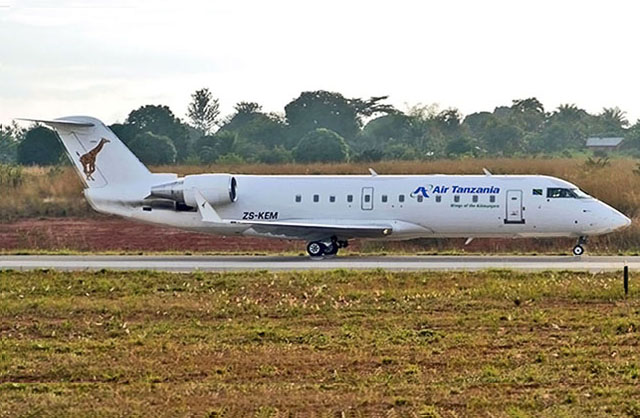
Air Tanzania Canadair CRJ-100 ZS-KEM leased from Airstream International (SA)att Kigoma Airport.
The Airbus A320 agreement was not yet solved. After Wallis sued for the sums due, the airline and the Tanzanian government put forward a number of defenses, including that the goverments's representant entered into the lease “without consulting with, let alone obtaining approval from, the board of ATCL, and he did not have the approval of the board of ATCL to sign the lease.”
But the judge rejected that defense and the others. The government and ATCL were represented by Attorney General Adelardus Kilangi and Deputy Solicitor General of Tanzania Gabriel Malata.
"The evidence indicated that it made a commercial bargain with an entity which was regarded as being subject to a number of risks, and in circumstances where it is not apparent that anyone else was prepared to offer ATCL better terms,” the judge said.

AirTanzania De Havilland Canada Dash Q311 5H-MWF loadingcargo at Mwanza airport

Air Tanzania DE Havilland Canada Dash Q311 5H-MWF disembarking passengers at Tabora Airport Air Tanzania ma Airport.
Despite setbacks with two lost aircraft in Mwanza and Kigoma and three failed aircraft leasing agreements, Air Tanzania continues to maintain its air service to Kilimanjaro, Mwanza and Tbora and Kigoma, albeit with delays and cancellations
In 2016, the Tanzanian government under President John Magufuli initiated a new drive to revive the national carrier. The government purchased two new De Havilland Canada Dash 8-400 (ex Bombardier) for the national carrier to delivered in September 2016.
Now there is no turning back - the people are complaining about the government's bad decisions - look forward to Air Tanzania's come back instead.
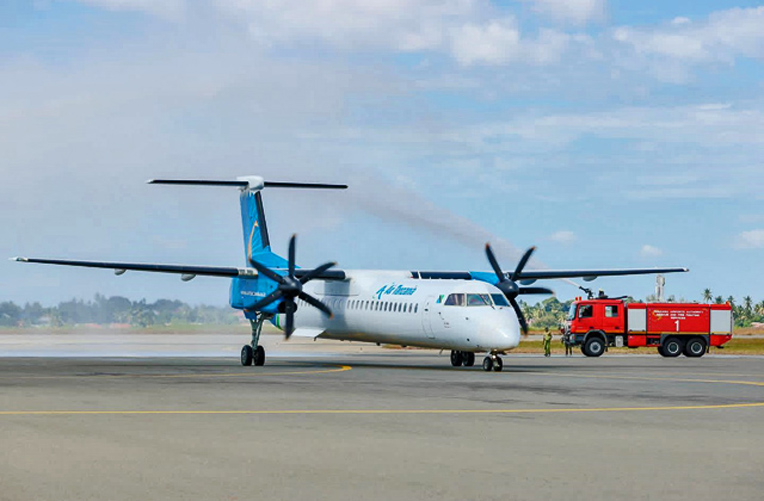

Air Tanzania 1st De Havilland Canada Dash 8-400 5H-TCB at Dar es Salaam Int Airport 2016
To protect the government's investments from debt collectors, the government, through its Tanzania Government Flight Agency (TGFA), took delivery of two Bombardier Q400 turboprop aircraft at Julius Nyerere International Airport in Dar es Salaam and leased the aircraft to Air Tanzania.
On 2 December 2016, Bombardier Commercial Aircraft announced that the Tanzanian government, acting through its TGFA, had signed firm purchase agreements for two CS300 jetliners and one Q400 turboprop aircraft for lease to Air Tanzania. The CS300 aircraft was later known as Airbus A220-300 aircraft. The TGFA also ordered two Boeing 787 Dreamliner aircraft valued at US$224.6 million at list prices.
With the new airplanes, Air Tanzania resumed service to various domestic destination

Air Tanzania Boeing De Havilland Canada Dash 8-400 5H-TCE at Dar es Salaam Int Airport.
On 2 April 2018, Air Tanzania received its third Q400 aircraft with tail number 5H-TCE. This aircraft had been scheduled to be delivered in August 2017, but the delivery was delayed after being seized by Canadian contractor Sterling following the Tanzanian government's unwillingness to settle a US$38.7 million debt awarded to the contractor by the International Court of Arbitration in 2010.
By March 2018, the legal situation was brought under control and the seized plane was released.

Unbelievable, on 8 July 2018, Air Tanzania took delivery of a Boeing 787 Dreamliner 5H-TCG, to be deployed on intercontinental flights. All were there to celebrate the remarkably history in the Air Tanzania history.
 Air Tanzania Airbus A220-300 5H-TCH "Dodoma".
Air Tanzania Airbus A220-300 5H-TCH "Dodoma".

Air Tanzania received its first Airbus A220-300, registered as 5H-TCH, in December 2018 christened Dodoma and second on 11 January 2019 christened Ngorongoro and registered as 5H-TCI. The airline became the first African operator of this aircraft type and the fifth airline globally with an A220 family airplane.

This is not the first time an Air Tanzania aircraft, A220-300 5H-TCH was seized, here seen at Oliver Tambo Int airport in Johannesburg.
In August 2019, one of the Airbus 220s was seized at O R Tambo International Airport in Johannesburg due to unpaid debt owed by the Tanzanian government. The airline subsequently suspended all flights to South Africa, citing safety concerns over xenophobic attacks. The airline continues to be unable to service certain destinations of the fear of the planes being impounded.
This is also not the first time Air Tanzania has had a plane seized. In 2017, Canadian construction firm Stirling Civil Engineering seized the airline's new Bombardier Q400 plane in Canada over a $38m lawsuit.
The Q400 was released in March 2018 after Tanzania's prime minister and attorney general negotiated its release. No details were given about the terms of the settlement.

We are ready to fly with you!
On 25th March 2020, Air Tanzania temporarily suspended all flights to Entebbe, Uganda, Bujumbura, Burundi, Hahaya, Comoro, Lusaka, Zambia and Harare in Zimbabwe.
All other domestic flights on the ATCL network were not affected, though there were frequencies reductions due to shrinking of volumes on some routes since not travelers were taking precautions on unnecessary trips.
The airline also plans to grow its cargo operations and at the Dubai Airshow 15 November 2021 placed its first order of a Boeing 767-300 Freighter. The total order was for valued at more than $726 million at list prices which included a new Boeing 787-8 Dreamliner and two Boeing 737 MAX. The airline began its first dedicated cargo flight to Guangzhou Airport in mid 2021 as passenger service was delayed due to COVID-19 restrictions in mainland China.
A smoke incident on an Air Tanzania Airbus A220-300 on February 24, was the third such occurrence on the type in the space of seven months and has once again drawn global attention to the teething engine issues that continue to plague the type.
This Air Tanzania aircraft was seized in December 2022 following a dispute between the Tanzanian government and a Swedish energy company. Following a constructive discussion between the state and the Swedish firm, the single-aisle aircraft was returned to Air Tanzania Company Limited on 23 July 2023

On July 30, Tanzania’s president, Samia Suluhu Hassan welcomed the fifth Dash 8-400 5H-TCK "Saadani National Park" in Dar es Salaam. According to the aircraft manufacturer, it is the last of its type.

Air Tanzania held a media briefing on Thursday where it shared details of the events surrounding one of its flights, a service from Dar es Salaam to Mbeya operated by an Airbus 220-300.
The government of Tanzania expected to spend TZS468 billion shillings (USD201million) to purchase five aircraft - including two B737-9 MAX to be placed with Air Tanzania (TC, Dar es Salaam) in the coming financial year, according to Transport Minister Hon. Makame
Mbarawa. Tabling his ministry's budget in the National Assembly on May 23, he said the
government had entered contracts for the purchase of two B737-9 MAX, one B787-8, one B767-300F freighter, and two DHC-8-Q400s.
The new aircraft were expected to be delivered in early 2023. The aim was to expand Air Tanzania's reach as a regional passenger and cargo carrier and to make Tanzania a main transport and logistics hub in East Africa.
In the past nine months, Air Tanzania has received three new aircraft, including two A220-300s carrying 132 passengers each and one DHC-8-Q400 turboprop for 76 passengers. By April 2022, Air Tanzania had a fleet of 11 active aircraft,
compared to eight in February 2020.
The announcement raised eyebrows amongst local media, which pointed out that more than 65% of the TZS36.18 billion (USD15.5 million) losses sustained by Air Tanzania in the 2020/21 financial year were due to the pandemic-linked inactivity of its two
B787-8s. This had been disclosed by the country's Controller and Auditor General (CAG) in
his 2020/21financial report. He ascribed the airlines'
losses to most of Air Tanzania's in-house fleet having cost more to operate than the revenue they generated.
Only two of its aircraft - one of its two active A220-300s and one DHC-8-Q400 - generated
profits in 2020/21. Air Tanzania's current fleet comprises: four A220-
300s, two B787-8s, five DHC-8-Q400s, one DHC-8-Q300 (inactive stored at Malta). The entire compliment is owned by TGF - Tanzania Government Flight (Dar es
Salaam) which in turn leases them out to Air Tanzania.
Meanwhile, between July 2021 and April 2022, Air Tanzania had transported 53% more
passengers than in the same period the year before, totaling 663,016 passengers. On the cargo side, it had exported 1,953 tonnes - an increase of 70% compared to 1,152 tonnes transported in the same period in 2020/21. This increase was due to the introduction of cargo flights between Guangzhou, China and Dar es Salaam, Tanzania from August
2021, as well as the resumption of Mumbai Int'l flights from India, which had been postponed.
Air Tanzania announced on 12 November a temporary suspension of some of its services because of the ongoing technical problems with the Pratt & Whitney engines on some of its Airbus A220s. The East African airline does not have a target date by which it hopes to resolve this issue, so half of its A220 fleet remains grounded for the foreseeable future.
 Air Tanzania A220-300 sized in the Netherlands for almost seven month.
Air Tanzania A220-300 sized in the Netherlands for almost seven month.
2023 "THE NEW AIRCRAFTS YEAR"

On the arrival of Air Tanzania Boeing 767-300 Cargo 5H-TCO the President and her staff celebrated the new aircraft at Dares Salaam Int Airport.
 Preparing the Boeing 767-300 Cargo 5H-TCO for its first departure-
Preparing the Boeing 767-300 Cargo 5H-TCO for its first departure-
 Next new aircraft to arrive was the 1st Air Tanzania Boeing 737MAX9 5H-TCP named Olduvai Gorge on October 4th, 2003. The Boeing 737 is back in the fleet!
Next new aircraft to arrive was the 1st Air Tanzania Boeing 737MAX9 5H-TCP named Olduvai Gorge on October 4th, 2003. The Boeing 737 is back in the fleet!

Air Tanzania is going strong forward with almost new or new aircraft in its fleet. Air Tanzania will probably be a leading airline with rather close connections to Asia.

Tanzanian government officials led by Prime Minister Kassim Majaliwa receive Air Tanzania’s second Boeing 737 MAX 9 5H-TCQ " Ruaha National Park" at Julius Nyerere International Airport in Dar es Salaam, Tanzania on March 26, 2024
 Air Tanzania Boeing 737MAX9 5H-TCP arriving Mumbai Chhatrapati Shivaji Int Airport.
Air Tanzania Boeing 737MAX9 5H-TCP arriving Mumbai Chhatrapati Shivaji Int Airport.
Photo: Aneesh Bapaye, Jetphotos
 Air Tanzania Boeing 737MAX9 5H-TCP at Dubai International Airport 2024. UAE.
Air Tanzania Boeing 737MAX9 5H-TCP at Dubai International Airport 2024. UAE.
 After more than three years of maintenance, Air Tanzania Bombardier DHC-8-311Q Dash 8 5H-MWF here seen on final to Malta International Airport.
After more than three years of maintenance, Air Tanzania Bombardier DHC-8-311Q Dash 8 5H-MWF here seen on final to Malta International Airport.